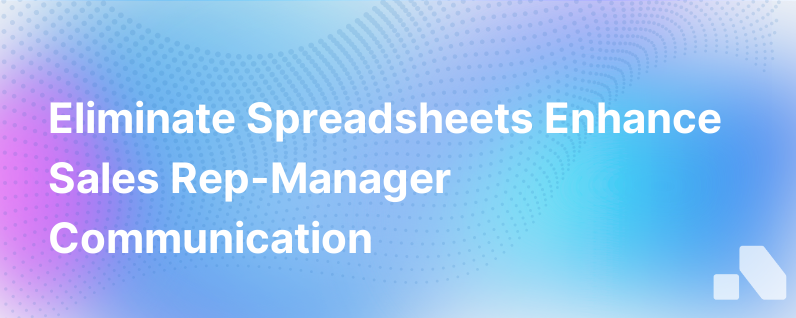Eliminating The Spreadsheet How To Improve Sales Rep Manager Communication
Published on October 5, 2023 by David Zhang
Spreadsheets were once the backbone of business operations across the globe, a testament to their versatility and early introduction into the digital working world. However, while spreadsheets remain helpful, they are no longer the most efficient tool for every task—particularly when it comes to facilitating communication between sales reps and their managers. In the realm of sales, rapid-paced, streamlined collaboration is paramount, and the era of spreadsheet-reliant strategies may well be eclipsed by more dynamic, efficient alternatives.
In this deep dive, we'll explore robust methodologies and cutting-edge tools poised to revolutionize communication between sales reps and their management, moving towards a spreadsheet-free sales ecosystem that thrives on clarity, precision, and real-time collaboration.
Understanding the Spreadsheet Dilemma
Traditionally, sales reps have relied on spreadsheets for tracking customer interactions, opportunities, and revenue forecasting. However, inefficiencies become apparent when considering the dynamism of the sales process. Issues related to version control, lack of real-time updates, and the risk of human error in data entry can lead to miscommunication and missed opportunities.
To compound matters, spreadsheets can be cumbersome and ineffectual for visually representing data or offering actionable insights quickly. As any seasoned sales rep will tell you, the key to harnessing a successful sales strategy hinges on agility - responding to leads promptly, navigating customer needs astutely, and adapting to market changes with alacrity.
Strategies to Enhance Sales Rep-Manager Communication
Implementing a Centralized CRM System
The inception of Customer Relationship Management (CRM) platforms heralded a new era in sales. CRMs centralize communication, automate tracking processes, and provide a single source of truth for customer data and sales activities. These systems allow for live updates, ensuring both reps and managers have real-time access to relevant information, enabling immediate responses and strategic decisions.
Embracing Real-Time Communication Tools
Slack, Microsoft Teams, and other instant messaging platforms provide a digital space for constant and immediate exchange between sales reps and their managers. Quick questions can be addressed on the fly, deals can be discussed in dedicated channels, and information can cascade through the ranks in a flash, minimizing delays inherent in long email threads or the static rows of a spreadsheet.
Visual Dashboards and Reporting
Visualization tools, integrated within modern CRMs or as standalone business intelligence platforms like Tableau or Microsoft Power BI, offer dynamic, real-time insights that transcend the capabilities of traditional spreadsheets. These dashboards provide at-a-glance performance metrics that are comprehensible and actionable, facilitating better strategy conversations between reps and managers.
Automated Reporting Systems
Through automation, regular sales reports can be generated and disseminated without the need for manual compilation, which is often a source of error and miscommunication in spreadsheet-dominated workflows. Reps can focus on selling, while managers get the insights they need without the back-and-forth.
The Role of Mobile Access
Mobile-friendly CRMs and communication apps ensure that reps on the field can access information, report back, and stay connected with their managers without needing to power up a laptop and trawl through a spreadsheet. The immediacy of mobile access aligns well with the on-the-go nature of sales work.
AI and Machine Learning for Predictive Sales Data
Emerging technologies like Artificial Intelligence (AI) and Machine Learning (ML) are revolutionizing communication by providing predictive analyses of sales trends and buyer behaviors. Platforms that harness AI, such as Aomni, offer managers refined insights into their reps' pipelines, allowing for preemptive strategy adjustments and targeted coaching.
Collaborative Forecasting Approaches
In lieu of static spreadsheet forecasts, collaborative forecasting tools within CRMs allow for a shared view of projected sales. This multi-tiered approach ensures all voices are heard and that the forecasts reflect the ground reality, as experienced by the reps.
Consistent and Structured Check-ins
Digital meeting schedulers and calendar apps can aid in regularizing check-ins, replacing ad hoc and often erratic update meetings that stem from reactionary spreadsheet analyses. Structured check-ins foster a rhythm of predictable, productive interactions between reps and their managers.
Training and Onboarding for New Tools
Adoption of new systems hinges on adequate training. A well-designed onboarding process for sales reps ensures that they are comfortable and proficient with the tools intended to supplant spreadsheets, streamlining internal communication processes from the get-go.
Integrating Advanced Analytics for Decision-Making
Tools that deliver advanced analytics can empower sales managers to make informed decisions about territories, commission strategies, and market focus areas, moving beyond the rudimentary analysis that spreadsheets afford.
Conclusion: The Path Away from Spreadsheets
The migration from spreadsheet dependency to a multifaceted ecosystem of communication and information management tools is paving the way for sales teams to harness higher levels of efficiency and effectiveness. Through the careful integration of CRMs, real-time communication platforms, visualization dashboards, and predictive analytics, sales rep-manager dialogues can be transformed into ongoing, strategic partnerships that drive success.
Embracing these tools and strategies will not only ensure that sales teams are working from the most accurate and up-to-date information but will also foster a culture of transparency and proactive engagement. This evolution in sales communication is less about discarding spreadsheets altogether than it is about leveraging the right mix of tools for the right tasks—and in doing so, elevating the entire sales operation to meet the swift pace of today's business landscape.